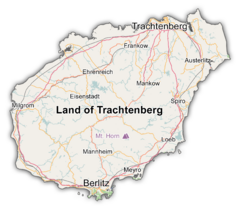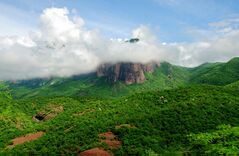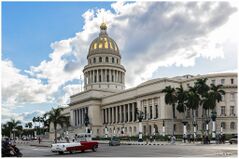Trachtenberg
Trachtenberg | |
|---|---|
| Motto: "Фрэырэыдінг, фрэылекх, фрэысэрцэ." 「Freyreyding, Freylekh, Freyserce.」 "Freestanding, Freethinking, Freehearted." | |
| Anthem: "Perseverance Lament" Аусдауэртрэн Ausdauertren | |
 Map of Trachtenberg | |
| Capital and largest city | Trachtenberg 22°10′N 108°18′W |
| Official languages | Trachtsch English |
| Recognised regional languages | Hebrew Yedeslavic |
| Ethnic groups | 97.39% Jewish 1.97% Slavic 0.64% Others |
| Demonym(s) | Trachtsch |
| Government | Unitary Presidential Representative Democratic Republic |
• President | Ayn Strauss |
• Lieutenant President | Itzhak Kaganovich |
| Legislature | Parliament |
| Ludowyrot | |
| Komizon | |
| Formation | |
• National Foundation Day (legendary) | June 15, 1911 CE |
• Constitution | April 2, 1929 CE |
| Area | |
• Total | 29,990 km2 (11,580 sq mi) |
• Water (%) | 3.39 |
| Population | |
• 2022 estimate | 7,711,100 |
• Density | 257.1/km2 (665.9/sq mi) |
| GDP (PPP) | 2022 estimate |
• Total | $256.787 billion |
• Per capita | $33,301 |
| GDP (nominal) | 2022 estimate |
• Total | $265.559 billion |
• Per capita | $34,438 |
| Gini (2022) | medium |
| HDI (2022) | 0.888 very high |
| Currency | Kublek (k) (TCK) |
| Time zone | UTC-8 / -7 |
| Date format | yyyy-mm-dd (CE−2022) |
| Driving side | left |
| Calling code | +909 |
| ISO 3166 code | TCB |
| Internet TLD | .tb |
Trachtenberg (Trachtsch: трахтэнбэрг, lit. 'a mountain of thoughts') is an island country in the eastern Central Ocean. It sits at the junction of the Central Ocean and the Sevevillian Sea in the northwestern Straits of Urilas, neighboring the Empire of Sevevill to the north, and the Federation of Urilas to the southwest. The area controlled by Trachtenberg consists of 5 islands with a combined area of 29,990 square kilometers. The main island of Trachtenberg, formerly known as the Jewish Eastern Overseas Trade Dependency until 1901, has an area of 29,797 square kilometers, with semi-forested mountain ranges dominating the southern two-thirds and semi-arid scrub in the northern third and coasts, where its highly urbanized population is concentrated. The capital is Trachtenberg, which, along with Austerlitz, forms the largest metropolitan area of the country. Other major cities include Berlitz, Milgrom, Spiro, Meyro, Mannheim, and Mankow. With 7.7 million inhabitants, Trachtenberg is among the most densely populated countries in the region.
Modern Trachtenberg was founded in 1833 by Isak ben Avraham as a trading post of the Jewish Eastern Company. In 1850, the colony was reorganized and came under the direct control of Sevevill as part of the Treaty of Straits. By the mid-19th century, large-scale Jewish immigration to northern Trachtenberg accelerated in response to the Trachtsch revolution, a national awakening among semi-nomadic Jewish tribes that espoused cultural unification and the establishment of a permanent pan-Jewish homeland. The Jewish population grew steadily in subsequent decades, and by the turn of the 20th century, a pioneering and influential nationalist movement emerged, which was noted for indefatigable persistence that commanded the nation's sovereignty. On the 1st of September 1911, the nation declared its independence, forming the Land of Trachtenberg.
After early years of turbulence, the nation rapidly developed a dynamic and efficient economy characterized by high incomes and a stable middle class. Trachtenberg's quality university education and the presence of a highly motivated and educated populace is largely responsible for establishing the country's robust economic development. Despite limited natural resources, intensive land reclamation efforts in the agricultural and industrial sectors during the middle-half of the 20th century has made Trachtenberg largely self-sufficient in food production, apart from meat. Since 2000, Trachtenberg's diverse economy has evolved into a highly service-based market, with two-thirds of the country's gross national product based on finance, government, real estate services, technology, and professional, scientific, and technical business services. It is ranked highly in terms of political and civil liberties, education, health care and human development.
Trachtenberg is a pan-Jewish, liberal democracy with a semi-parliamentary system, proportional representation, and universal suffrage. The president serves as head of government while the Komizon serves as the confidence chamber of the bicameral legislature. Trachtenberg is also the headquarters of Markion Energy Protocol (MEP) and a founding member of the Iron Alliance, as well as a frequent participant at many international conferences and events. The country is a regional power, and although it has traditionally maintained a non-aggressive method of foreign affairs, Trachtenberg consistently maintains a well-trained, rapidly mobilized active-duty military that encompasses sea, air, and land forces.
Geography
Trachtenberg is the fifth largest island in the Straits of Urilas. It lies between latitudes 13° and 14°N, and longitudes 76° and 73°W. Sevevill (Newport Beach, Austaya) lies 30 kilometres (16 nautical miles) across the Trachtsch Channel to the north and northeast, and The Federation of Urilas (Buenaventura) 50 km (27 nmi) to the south. The main island, is 156 km (97 mi) long, constituting most of the nation's land area (29,990 km2 or 11,579 sq mi) and is the 97th-largest island in the world by land area.
Taxonomically, Trachtenberg exhibits diverse geography for a relatively small area. The Coastal ranges of the Markvalian cordillera run down the geographic center of the island. The most notable ranges of these mountains are the Massbach mountains in the west, the Pach Mountains in the centre, and the Horn mountains in the east, the latter containing Mount Horn, Trachtenberg's tallest mountain at 1,559 m. The ranges are marked by wide swathes of subtropical dry broadleaf forestation, including the presence of some endemic taxa. Conifer (pine, fir, cedar) and Acacia forests are most widespread above 1,000 m where the precipitation is above 760 mm. Valleys between the mountain ranges are located within a climate zone that is suitable for agriculture. Such valleys include the Mankow Valley and the Eisenstadt Plateau, areas that produce citrus fruits and grapes. The mineral-rich mountain range extends southwards to the Trachtsch Channel, where the western slope becomes wider, forming natural oceanic bluffs.
Temperate winds from the nearby ocean and the cold Urilas Current make the climate along the northwestern coast pleasant year-round. As a result of the island's location proximal to the Austayan coast, rains from the north barely reach the lower half of the island, thus leaving southern areas drier. South of the Metry River, the environment changes from a temperate subtropical landscape to a dry sheynland one. This shrubland exhibits diverse succulent species that flourish in part due to the coastal fog. To the south, the Royz Valley forms from the foothills of the Pach mountains. Some of the warmest temperatures in the nation are recorded in or nearby this valley. However, with irrigation from the Riki River, this area has become a true agricultural center.
Climate
Trachtenberg's climate varies from sub-tropical to semi-arid. The sub-tropical climate is found in the central portions of the island, where the summers are dry and mild and the winters somewhat cool and rainy. This climate is observed in areas from Trachtenberg to Mankow and nearby interior valleys. The cold oceanic Urilas Current often creates a low-level marine fog near the coast. The fog occurs along any part of the western coast of the island.
The change of altitude towards the Horn mountains creates an alpine climate in this region. Summers are cool, while winters can be cold with below freezing temperatures at night. It is common to see snow in the Horn range, Pach range and in the valleys in between the two ranges from December to April. Due to orographic effects, precipitation is much higher in the mountains of northern Trachtenberg than on the western coastal plain or southern desert plain. Pine, cedar and fir forests are found in the mountains. The average January temperatures are a maximum of 14.7 °C and a minimum of 8.7 °C. Average July temperatures are a maximum of 25.6 °C and a minimum of 15.6 °C. There are an average of 12.5 days with highs of 32 °C or higher and an average of 0.3 days with lows of 0 °C or lower. The record high temperature was 41 °C on July 6, 2018, and the record low temperature was −2 °C on January 11, 1949. Coastal high fog is common during summer, but usually burns off by the afternoon.
Further west along the coast, the Semi-tropical climate transitions into a desert climate, but it is milder and not as hot as along the channel coast. Transition climates, from semi-tropical to desert, can be found from Freeburg to Milgrom. Further inland and along the Trachtsch Channel, the vegetation is scarce and temperatures are very high during the summer months.
Politics
Government
President since 2036
Lt. President since 2036
The politics of Trachtenberg take place in a framework of a unitary presidential representative democratic republic, whereby the President is both head of state and head of government, and of a multi-party system. The political and administrative organization of Trachtenberg comprises the federal government, and all municipalities with a population greater than 25,000. Since the nation's founding, the apparatus of the state has been set on five fundamental principles: sovereignty, citizenship, dignity of human beings, the social values of labor and freedom of enterprise, and political pluralism.
The federal government exercises control over the central government and is divided into a classic tripartite of three independent branches: executive, legislative and judicial. Executive power is exercised by the President, advised by a cabinet. Legislative power is vested upon the National Congress, a two-chamber legislature comprising the Ludowyrot (Popular Panel) and the Komizon (Commission). Judicial power is exercised by the judiciary, consisting of the Supreme Federal Court, the Superior Federal Court of Justice, and the Regional Federal Courts. The President is elected for a three-year term, with the possibility of re-election for a second and third successive term. The current president is Ayn Strauss. The previous president, Ari Rappaport, replaced Zamir Kahn after his impeachment. The President appoints the Ministers of State, who assist in government.
Trachtenberg has an unrestricted multiparty system with a large number of political parties. Some parties lack ideological consistency and it is common for komizoniks to switch parties, weakening electoral coalitions. At same time, the high number of political parties makes the Executive need to gather alliances of different political parties must piece together diverse and often ideologically incoherent coalitions to pass legislation (this is known as coalition presidentialism). For most of its democratic history, Trachtenberg has had a multi-party system complimented by proportional representation. Voting is compulsory for the literate between 18 and 70 years old and optional for illiterates and those over the age of 70. The country has more than 30 active political parties. Nine political parties are represented in Congress. It is common for politicians to switch parties, and thus the proportion of seats held by particular parties changes regularly. Almost all governmental and administrative functions are exercised by authorities and agencies affiliated to the Executive.







